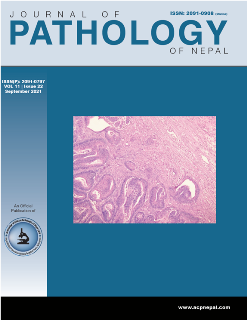Immunophenotyping pattern of mixed phenotypic acute leukemia: historical review and diagnostic pitfalls
DOI:
https://doi.org/10.3126/jpn.v11i2.34001Keywords:
Flowcytometry; Immunophenotyping; Mixed Phenotypic Acute LeukemiaAbstract
Introduction: Multiparametric approaches are used for the diagnosis and classification of acute leukemia. Even after extensive immunophenotyping, a rare and heterogeneous subgroup that cannot be readily classified as Mixed Phenotypic Acute leukemia in which the blasts exhibit the antigens of more than one lineage. This study aimed to analyze the incidence of Mixed Phenotypic Acute Leukemia and correlate the clinicopathological and immunophenotypic characteristics.
Materials and methods: This study was done in a tertiary health institute. Complete clinical details of patients were taken followed by morphological evaluation including peripheral blood, bone marrow aspiration, and biopsy was done. Immunophenotyping was performed on the FACS Canto II Flow cytometer. The diagnosis of Mixed Phenotypic Acute Leukemiawas based on the World Health Organization 2008 classification.
Results: We analyzed 7 cases, which include 57.14%of B/Mixed Phenotypic Acute Leukemia and 42.86% of T/Mixed Phenotypic Acute Leukemia. The male to female ratio was 0.4:1. Hematological parameters including hemoglobin, total leucocyte count, platelets count, and blasts percentage were correlated. On flow cytometry, all cases were positive for cMPO while B/Myeloid cases were positive for CD19 and at least one B cell marker. T/Myeloid cases were positive for cCD3 and CD7 in all cases besides other myeloid and T cell markers.
Conclusions: The frequency of Mixed Phenotypic Acute Leukemia in our study was found to be 2.7%, in concordance with published data (2.2-2.6%). Strict diagnostic criteria should be followed in the diagnosis because it originates from primitive multipotent progenitors which are resistant to treatment and lineage plasticity.
Downloads
Downloads
Published
How to Cite
Issue
Section
License
Copyright (c) 2021 Monika Gupta, Pooja Dhamija, Nisha Marwah; Sujata Kumari SP Prasad; Rajeev Sen

This work is licensed under a Creative Commons Attribution 4.0 International License.
This license enables reusers to distribute, remix, adapt, and build upon the material in any medium or format, so long as attribution is given to the creator. The license allows for commercial use.




